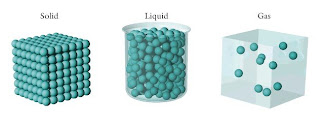|
Sunday, May 31, 2009 @ 11:27 PM
conduction what is conduction? - transfer of thermal energy through a medium, without it moving - conduction is the process of thermal energy transfer without any flow of the material medium how does conduction work? - can occur in solids, liquids and gases, but it works better and is more efficient in solids. why? ~ in liquids and gases, according to the kinetic model of matter, their molecules are spaced further apart than solids. ~ there would be lesser collisions in liquids and gases ~ so the transfer of kinetic energy from faster moving molecules (molecules of the hotter end of the liquid/gas) to the slower moving neighbouring molecules is slower ~ in solids, their molecules are closely packed so more collisions, kinetic energy is transferred ~ heat conducts through solids the fastest; liquids and gases are poor conductors of heat. - 2 types of conduction: molecular vibration and free electron diffusion ~ molecular vibration Ø when heat is supplied to one end, the molecules at the hot end vibrate vigorously Ø they collide with neighbouring molecules, making them gain kinetic energy and vibrate as well Ø kinetic energy at the hot end is transferred to the neighbouring molecules Ø quite a slow way molecules at the hot end vibrate and pass the kinetic energy to the other molecules at the cooler end ~ free electron diffusion Ø this type of conduction only takes place in metals as only metals have free electrons Ø when the metal is heated, the free electrons gain kinetic energy and move faster Ø the electrons then diffuse into the cooler parts of the metal, colliding with the molecules in the cooler part of the metal Ø much faster mechanism ~ comparing the 2 types Molecular vibration: occurs in solids(metals and non-metals), slow process Free electron diffusion: Occurs only in metals, faster process this explains why metals are more capable of transferring thermal energy more quickly: 1. metals have 2 methods of conduction occurring at the same time 2. in metals, free electron diffusion is the main mechanism, which is faster 1. conduction in solids this diagram shows an experiment of conduction through a copper rod and a glass rod to compare their rate of conduction what will be observed: ~ wax melts faster along the copper rod than the wax on the glass rod Ø copper is a conductor of heat Ø glass is an insulator Ø also shows that metals transfer thermal energy more quickly than non metals because of the presence of free electrons in metals experiment~ - 2 spoons, one plastic and the other metal is put into a cup of very hot water - equal amouts of butter is smeared on the spoons at the same level - the butter on the metal spoon melted faster than the butter on the plastic spoons - metals are better conductors of heat than non metal - heat travelled through the solid through conduction 2. conduction in liquids this diagram shows an experiment of conduction in water what will be observed: ~ the water at the upper end of the test tube boils quickly ~ the ice melts very slowly Ø thermal energy transfer through conduction from the water at the top to the bottom is very slow Ø it shows that water is a poor conductor of heat experiment when a matchstick is held away from a candle flame, it will not burst into flames this is because: - air between the matchstick and the flame is an insulator of heat in conclusion... - materials that conduct heat easily/are readily good conductors of heat.(eg. metals like copper, silver, steel, iron) - materials that do not conduct heat easily are insulators and poor conductors of heat.(eg. non-metals like glass, plastic, wood, brick, wool, air, water) - metals are conduct heat faster because they have 2 methods of conduction of which free electron diffusion is faster |
hello, welcome to my physics blog:) please comment, thanks!:) physics txbk chap 10: transfer of thermal energy oh all the blogger videos are done by clarissa and me:)haha profile
alyssa:)
3A1
comments
affiliates
linklink link link link This layout is done by balloon.s with the help from here. archives
May 2009
June 2009
|



